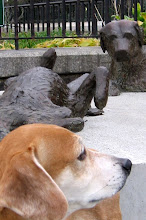On the first full day of spring -- mild and bright, perfect dog-walking weather -- I walked some books from my constant-use reference shelf out to my terrace, gave them a refreshing rubdown with a clean cloth, and a few hours' airing well away from direct sunlight. A good start to the season people who don't sneeze through it are so fond of, and I was, despite the satisfaction I get from a bit of book care, more concerned with how someone I don't now and never will know should be punished. Happiness, and a cheery balance of the day, came when I decided on the obvious: there's a biblioperp out there somewhere who must search for books desired and never find them -- in pristine condition.
What prompted my invigorating burst of spite was nothing less than a crime against books. Three evenings of reading a novel acquired secondhand, with all the sense of extra-fortuitous pleasure the surprise find gave me, were every so often interrupted by a small queasy anger that was in no way related to the story or the creative writing. Had I bought the book for resale, I would have rated it "near fine" -- until I discovered that within its 266 large octavo pages there are 17 prominent dog-ears. Those corners don't just turn down; they droop. I wonder if the perpetrator had visions of a hound.
I read past each offense with visions of the living dog ear -- so expressive, so pettable. And I wished, not for the first time, that dogs, whose lives real and imaginary so enrich literature, were not homonymously related to a bad act against books.
Is there ever an excuse, much less a reason, to dog-ear a book page? If you don't have a designated bookmark, get several, or make do with something else. Order bookmarks with your dog's picture; include one with every gift book you give. There are Internet sites that teach bookmark-making. Write yourself a note, jotting down the number of the page where your reading paused, and if you can't find the note, don't worry: remembering the page number is good brain exercise.
The perils of folding a book page’s corner are well known and real. If you needed to rig a collar-and-leash substitute, you wouldn't loop piano wire around your dog's neck: the slightest stress, and you'd induce pain if not injury. You'd find something strong but unabrasive that would give you and the dog security and comfort. And just as no dog needs expensive designer leashes or collars, no book needs more than a clean, dry, preferably acid-free bit of something thin and flat.
The dog-ear is a lazy convenience that can damage, leaving at best a visible scar, at worst an ugly stump when due to paper quality and/or age the result is amputation. Some remedies for dog-ears appear in The Care and Feeding of Books Old and New: A Simple Repair Manual for Book Lovers. From book arts professionals to book care hobbyists, the dog-ear is, as Wikipedia’s essay calls the practice, "generally frowned upon." Imagine your dog looking miserable, and transpose that sorrow to the page between your fingers; you’ll never dog-ear again.
As to the fault in my biblioperp's punishment -- that no one who would dog-ear a page cares about a book's condition -- I have an addendum. To have read the dog-eared book to its end, as the spacing of the wounds suggests, indicates a person who enjoys a good read. May that person read and read and learn and learn, and one day discover the error of dog-earing and turn over a new leaf, perhaps in a book about book care, and take better care of books ever after.
Subscribe to:
Post Comments (Atom)

No comments:
Post a Comment